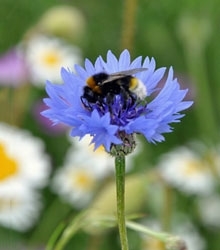Bumblebee
 I am sure we are all familiar with the call of the cuckoo heralding the arrival of spring, but what about the buzzing of the other “cuckoo” species telling us that the warm days of summer have arrived? Yes, as if our poor old bumblebees don’t have enough to be worrying about with a massive 97% of flower-rich meadows having gone, they also have to contend with their nests being raided by the “cuckoo bumblebee”!
I am sure we are all familiar with the call of the cuckoo heralding the arrival of spring, but what about the buzzing of the other “cuckoo” species telling us that the warm days of summer have arrived? Yes, as if our poor old bumblebees don’t have enough to be worrying about with a massive 97% of flower-rich meadows having gone, they also have to contend with their nests being raided by the “cuckoo bumblebee”!
In the UK there are six species of cuckoo bumblebees, which have, through evolution, become parasitic on their cousins. The female cuckoo bees force their way into the nests of their bumblebee hosts and kill or evict the queen and take over her workers as their own, using them to rear their own offspring. Each cuckoo species tends to attack a particular species of bumblebee.
There are 24 species of bumblebee found in the UK and most of them are in decline, because our green and pleasant land is just that – green – and not full of colour with masses of wild flowers. Pollen and nectar needs to be on offer in large quantities from March through to October if our bumblebees are to flourish. What is more, they are prepared to fly for over a mile from the nest to find it.
We know that they require high-quality pollen to feed to their young, which they can only get from certain plants such as clovers, vetches and trefoils, so these are particularly important. Because of this farmers are encouraged to plant these legume mixes and are paid to do so by the government, so that they can now be found on many farms across England, which hopefully will start to reverse the fortunes of these lovely insects.
The first bumblebee you see in early spring will be a queen feeding on flowers such as willow catkins or white dead nettle. She will soon build a nest, usually situated underground in an empty mouse hole or just above the ground in dense tussocky grass. Once the queen has created a nest, she collects lots of pollen and nectar and then lays her first batch of eggs. She incubates them just like a bird, sitting on them and 'shivering' her muscles to produce warmth.
The small white grubs hatch out and eat the pollen and nectar already in the nest, growing rapidly and eventually turning into pupae. After a few days the first all female workers hatch out and begin to gather more food, so that by mid-summer the nest can contain more than 400 worker bees. At this point the queen lays more eggs, which are this time both male and female. It is these females that will mate and burrow into the ground to hibernate until the following spring, when they emerge to start the whole process off once more. All the other bees including the males, workers, and the old queen die off in the autumn.
We can also help bumblebees by growing pollen and nectar-rich plants in our gardens. Lavender, bugloss, scabious, knautia macedonica and verbena bonariensis are all brilliant – but the best thing to do is just watch what they prefer in your own garden and plant some more of that, as every little helps!
Peter Thompson
Advisory

Download Peter Thompson's essential 26-page book, featuring beautiful photography and detailed profiles of Britain's wildlife
Download FREE >